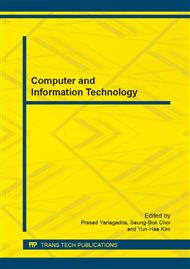[1]
M. Hasanuzzaman and K. Khrosani. Blind separation of convolved sources using the information maximization approach. Neural Networks. IJCNN'05. Proceedings. IEEE International Joint Conference, Vol. 2(2005), pp.1239-1244.
DOI: 10.1109/ijcnn.2005.1556031
Google Scholar
[2]
K. E. Hild, D. Erdogmus and J. Principe. Blind source separation using Renyi's mutual information. IEEE Signal Processing Letters, Vol. 8, No. 6(2001), pp.174-176.
DOI: 10.1109/97.923043
Google Scholar
[3]
A. Belouchrani, K. Abed-Meraim, J. Cardoso. A blind source separation technique using second-order statistics. IEEE Transactions on Signal Processing, Vol. 45, No. 2(1997), pp.434-444.
DOI: 10.1109/78.554307
Google Scholar
[4]
L. Tong, R. Liu, V. C. Soon and Y. Huang. Indeterminacy and identifiability of blind identification. IEEE Transactions on Circuits and Systems, Vol. 38, No. 5(1991), pp.499-509.
DOI: 10.1109/31.76486
Google Scholar
[5]
P. Chevalier, A. Ferréol and L. Albera. On the behavior of current second order blind source separation methods for first and second order cyclostationary sources-application to CPFSK sources. 2002 IEEE International Conference on Acoustics, Speech, and Signal Processing (ICASSP), Vol. 3, pp.3081-3084.
DOI: 10.1109/icassp.2002.1005338
Google Scholar
[6]
A. Ferreol and P. Chevalier. On the behavior of current second and higher order blind source separation methods for cyclostationary sources. IEEE Transactions on Signal Processing, Vol. 48, No. 6(2000), pp.1712-1725.
DOI: 10.1109/78.845929
Google Scholar
[7]
K. Abed-Meraim, Y. Xiang, J. H. Manton and Y. Hua. Blind source-separation using second-order cyclostationary statistics. IEEE Transactions on Signal Processing, Vol. 49, No. 4(2001), pp.694-701.
DOI: 10.1109/78.912913
Google Scholar
[8]
M. G. Jafari, J. A. Chambers and D. P. Mandic. Natural gradient algorithm for cyclostationary sources. Electronics Letters, Vol. 38, No. 14(2002), pp.758-759.
DOI: 10.1049/el:20020503
Google Scholar
[9]
J. Cardoso and B. H. Laheld. Equivariant adaptive source separation. IEEE Transactions on Signal Processing, Vol. 44, No. 12(1996), pp.3017-3030.
DOI: 10.1109/78.553476
Google Scholar
[10]
M. G. Jafari, S. R. Alty and J. A. Chambers. New natural gradient algorithm for cyclostationary sources. IEE Proceedings-Vision, Image and Signal Processing, Vol. 151, No. 1(2004), pp.62-68.
DOI: 10.1049/ip-vis:20040305
Google Scholar
[11]
J. Guo, Y. Gu. A fast convergence blind source separation algorithm based on cyclostationary statistics. Proceedings 2010 IEEE 12th International Conference on Communication Technology. pp.1472-1475.
DOI: 10.1109/icct.2010.5688971
Google Scholar
[12]
W. A. Gardner. Cyclic Wiener filtering: theory and method. IEEE Transactions on Communications, Vol. 41(1993), pp.151-163.
DOI: 10.1109/26.212375
Google Scholar


